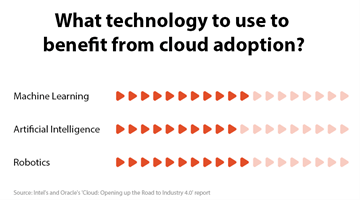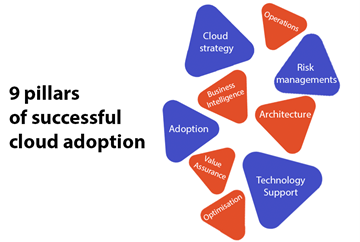Cloud computing in discrete manufacturing: challenges and opportunities
With ever-changing consumer requirements and needs, Industry 4.0 is yet another sector that’s has been rapidly evolving in the last few years. One of the crucial elements of this evolution has been cloud computing with its ability to store and analyse large amounts of data.
In this sector – and many other industries – information is essential for reducing costs and increasing the effectiveness of business processes. This – in turn – calls for intelligent and connected solutions where companies will not only be able to respond to external factors but also take in, account for and share data from a variety of devices, systems and products.
As of 2022, you don’t need to painstakingly analyse these details via in-house tools as there is already a number of infrastructure features that can support your company on its way to complete its digital transformation.
Companies operating within the Industry 4.0 sector seem to understand the role the cloud can play in modernising the sector. According to the report ‘Cloud: Opening up the Road to Industry 4.0’ published by Oracle and Intel, 65% of German businesses see building an integrated cloud solution as an opportunity to benefit from cloud-based Machine Learning, with 61% and 65% thinking the same about Artificial Intelligence and Robotics.

One of the biggest obstacles in implementing this integrated cloud approach is outdated and difficult to scale tech infrastructure – with the same report showing that 60% of German Industry 4.0 companies struggling to keep it up to speed.
In this article, we do not only explain what the benefits of implementing cloud-based solutions are in your data processing but also explain how to overcome technological challenges based on the experience of one of our clients in Germany.
What are the benefits of employing the cloud for manufacturing data processing?
Cloud services providers offer an extensive suite of services that ensure that your data will be stored securely. With AWS, Google Cloud or Microsoft Azure, you will be able to extend/reduce the number of virtual servers you use on demand which means that you keep the flexibility in developing new products and solutions.
In addition to this, the cloud is one of the fastest evolving technologies out there, with new services and infrastructure models being developed on an almost daily basis. Another advantage of the cloud is the fact that you can exclusively pick microservices that address your business needs and provide an ecosystem that supports your company growth with unmatched accuracy and precision.
Process for implementing cloud computing in Industry 4.0
Including cloud solutions into your manufacturing process may not be as difficult as it seems. Your company may already be collecting significant amounts of data, with machines being equipped with sensors and other built-in appliances solely for this purpose.
This was also the case for one of our customers from Germany producing road-building machinery who needed an advanced solution to help them optimise their processes and monitor the performance of their machines, so they could provide better maintenance services.
Our first step in this collaboration was developing an Internet of Things solution that would help transmit all these data from the machines into one system where they will be converted and processed accordingly. Once this procedure was completed, the system generates job reports that are now regularly sent to the customer’s team.
They are also able to provide similar on-demand reports to their partners and clients for the machines that these parties bought or leased from them. As the next step, the system helps them analyse the effectiveness of the machines and calibrate them so they would perform even better.
The data from the machine has been stored in the cloud until now. We’re currently developing a set of integrations that would allow for it to be transferred to external databases such as Enterprise Resource Planning (ERP) and/or third-party applications of different types.
It’s important to note here that including the cloud in your manufacturing processes and integrating it with your existing service and product if you’re doing it on your own may be more difficult than you think. According to the newly released 2021 McKinsey’s survey results on cloud adoption in discrete manufacturing, 74% of companies overestimated their capabilities for fully integrating the cloud, with 50% of them claiming that the process is far more complex than anticipated and 40% of them having to overrun their budget.

The response to these cloud adoption struggles could be relying on a trusted technology partner that will be able to not only guide you through the process but take the responsibility for at least several crucial stages, so you don’t need to build capabilities to cover all of it at once.
What will you gain by using cloud-based solutions in your Industry 4.0 projects?
Using cloud-based services also allows you to run advanced engineering and design simulations so you can be sure you’ve chosen the best techniques and tools before you’ll actually start using them. This way, your company will be able to not only innovate faster but also cut the time of delivering your solution/product to the market.
With advanced Machine Learning solutions, you’ll also be able to make better, more informed business decisions based on real-time analytical visualisations and predictions without the costly and overly complicated infrastructure that would take months to set up. All of this also means that your decision process will be faster so if there’s an emergency, you’ll know how to respond to it, minimising the number of errors and preventing further failures.
Once your cloud transformation process is completed, your plant will operate as a smart factory, with your machines exchanging information in real-time, sending their data to external systems that will improve your business operation and even taking intelligent actions. This way, your business will be able to modernise the supply chain, quickly address changing market demand by providing information to your warehouse partners, suppliers, logistics and transportation teams.
What do you need to start including the cloud in your manufacturing processes?
According to McKinsey’s report mentioned earlier in this article and our own experience, there are at least 9 pillars of a successful cloud adoption procedure. You not only need to meticulously plan for it, but also make sure that the execution will be flawless. Also, make sure that you not only get your tech department on board, but also communicate and account for feedback from business and production teams as well.

These 9 pillars are as follows:
Cloud strategy
As mentioned above, precise and planning is no. 1 factor to ensure the success of your cloud adoption process. This must include, but is not by any means limited to:
- business objectives and model,
- success measures and threats,
- risk management goals,
- available resources,
- and a detailed roadmap.
Business Intelligence components
This is where you collect and analyse data from all the divisions of our company that will be involved in the cloud transformation and customer insights.
Architecture and services
Whether you’ll choose AWS, Google Cloud, Azure or any other cloud provider, you need to plan how the architecture will be built and what services to use.
Adoption
Migrating your data to the cloud can be risky – check our success story to check how we completed this procedure for one of our customers.
Operating model
Some of the questions to answer to support this pillar are:
- Which parts of the process can you automate, and how to do it right?
- Is your organisation model a possible threat or a supporting factor? If it’s the former, how can you adjust it?
- What resources are available to you? What are your team’s skills and capabilities?
- Who will own and manage the cloud adoption process as a whole?
- If your team is lacking the necessary abilities, where can you turn for support?
Optimisation
This pillar includes cost optimisation as well as process optimisation.
Risk management
There may be certain standards such as ISO9001 to help you fulfill all requirements and support your workflow.
Value assurance
This aspect should be ensured at the planning stage – make sure that you know exactly what you want to achieve with cloud adoption and how you’ll measure its success.
Technology support
As confirmed by our customers, completing a cloud adoption process can be difficult enough on your own, so reliable help from a technological partner is one of the key aspects that can make or break the procedure.
If you’re ready to start your cloud transformation or you’d like to discuss your business needs and challenges, please do not hesitate to contact our Head of Cloud Engineering, Lukasz Marcinek at lmr@spyro-soft.com or via our Cloud Engineering website.
About the author




